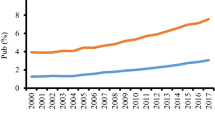Abstract
Recent discussion about the increase in international research collaboration suggests a comprehensive global network centred around a group of core countries and driven by generic socio-economic factors where the global system influences all national and institutional outcomes. In counterpoint, we demonstrate that the collaboration pattern for countries in Africa is far from universal. Instead, it exhibits layers of internal clusters and external links that are explained not by monotypic global influences but by regional geography and, perhaps even more strongly, by history, culture and language. Analysis of these bottom-up, subjective, human factors is required in order to provide the fuller explanation useful for policy and management purposes.




Similar content being viewed by others
References
Adams, J. (2012). Collaboration: The rise of research networks. Nature, 490, 335–336.
Adams, J. (2013). The fourth age of research. Nature, 497, 557–560.
Adams, J., Gurney, K. & Marshall, S. (2007). Patterns of international collaboration for the UK and leading partners. Report commissioned by the Office of Science and Innovation, pp. 27 Department of Innovation, Universities and Skills, London. http://www.bis.gov.uk/assets/BISCore/corporate/MigratedD/publications/I/ICPRUK09v1_4.pdf. Accessed 5 June 2013.
Adams, J., Gurney, K. A. & Pendlebury, D. (2012). Neglected Tropical Diseases, pp. 1–16. Global Research Report, Thomson Reuters, Philadelphia. ISBN 1-904431-31-3.
Adams, J., King, C. & Hook, D. (2010). Africa, pp. 1–9. Global Research Report, Thomson Reuters. ISBN 1-904431-25-9.
Adams, J., King, C., Pendlebury, D., Hook, D., Wilsdon, J. & Zewail, A. (2011). Exploring the changing landscape of Arabian, Persian and Turkish research, pp. 1–8. Global Research Report, Thomson Reuters. ISBN 1-904431-27-5.
Bishoff, N. (2010). South–South research collaboration of countries in the Southern African Development Community (SADC). Scientometrics, 84, 481–503.
Clauset, A. (2005). Finding local community structure in networks. Physical Review E, 72, 026132.
Frame, J. D., & Carpenter, M. P. (1979). International research collaboration. Social Studies of Science, 9, 481–497.
Georghiou, L. (1998). Global cooperation in research. Research Policy, 27, 611–626.
Greene, M. (2007). The demise of the lone author. Nature, 450, 1165.
King, C. (2012). Multiauthor papers: Onward and upward. Science Watch, 23, 1–2.
Leydesdorff, L., & Wagner, C. S. (2008). International collaboration in science and the formation of a core group. Journal of Informetrics, 2(4), 317–325.
Leydesdorff, L., Wagner, C. S., Park, H. W., & Adams, J. (2013). International collaboration in science: The global map and the network. El Profesional de la Información, 22(1), 87–94.
OECD, African Development Bank, United Nations Economic Commission for Africa and United Nations Development Programme. (2011). African Economic Outlook 2011: Africa and its emerging partners. Paris: OECD Publishing. ISBN 9789264111752.
Onyanche, O. B. (2011). Knowledge production through collaborative research in sub-Saharan Africa: How much do countries contribute to each other’s knowledge output and citation impact? Scientometrics, 87, 315–336.
Persson, O., Glanzel, W., & Danell, R. (2004). Inflationary bibliometric values: The role of scientific collaboration and the need for relative indicators in evaluative studies. Scientometrics, 60, 421–432.
Wagner, C. S. (2008). The new invisible college. Washington, DC: Brookings Press.
Wagner, C. S., & Leydesdorff, L. (2005). Network structure, self-organization, and the growth of international collaboration in science. Research Policy, 34, 1608–1618.
Author information
Authors and Affiliations
Corresponding author
Rights and permissions
About this article
Cite this article
Adams, J., Gurney, K., Hook, D. et al. International collaboration clusters in Africa. Scientometrics 98, 547–556 (2014). https://doi.org/10.1007/s11192-013-1060-2
Received:
Published:
Issue Date:
DOI: https://doi.org/10.1007/s11192-013-1060-2




